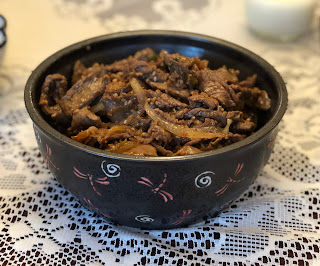This past August, I picked up the current issue of Southern Lady. I was initially drawn to the picture of the apple cream cheese cake on the cover. What actually sold me was a recipe for brisket pies. I knew that we were planning to smoke a brisket for an upcoming event so I was eager to give it a try.
Before we proceed with the recipe, here's a little extra information about brisket.
As you can see from the picture above, brisket is one of the key cuts of beef. Because cattle do not have collar bones, the muscles comprising the brisket support about 60% of the animal's weight - who knew? At any rate, this cut of meat contains a fair bit of connective tissue that needs to be tenderized during the cooking process. Marinating and then smoking the brisket is one way to accomplish this process and provides pretty amazing results. Let's just say our smoker has been well used through the years.
So, let's get on with this recipe…
Given that we were making hand pies, this was a great way to use up some of the scraps of brisket. Because they are rather small, you only need about 3/4 pound of chopped brisket.
Here is how we put ours together:
First we made the crust. Go with whatever piecrust recipe you like best. The one in the Betty Crocker cookbook is my go-to recipe. I used the amounts given for a 2-crust 10-inch pie. You will need to double the recipe provided below to have enough pastry for the amount of brisket that you will use. I found it easier to make one recipe-worth of pastry and then repeat so that it was easier to combine and manage the ingredients.
- 1 cup shortening, I like to chill mine in the freezer before using
- 2 2/3 cup flour
- 1 teaspoon salt
- 7 to 8 tablespoons cold water.
Stir the flour and salt together. Cut the shortening into the flour and salt using a pastry cutter. Stir in the water a couple of tablespoons at a time until all of the flour is moistened and the pastry can be gathered into a ball. Take care not to over stir or the pastry will be too tough.
Roll the pastry out in batches to about 1/4 inch thickness. Cut into 4.5-inch circles. Fortunately, we found a canister lid in the house that was exactly 4.5 inches in diameter and were able to use it for these pies. Feel free to use whatever works for you. We ended up with 16 circles. As you follow the pictures, you will be able to see how we laid them out on the baking sheets. A few years back, we found these handy-dandy silicone liners for the baking sheets. They are amazing.
Here are the ingredients for the filling:
Roll the pastry out in batches to about 1/4 inch thickness. Cut into 4.5-inch circles. Fortunately, we found a canister lid in the house that was exactly 4.5 inches in diameter and were able to use it for these pies. Feel free to use whatever works for you. We ended up with 16 circles. As you follow the pictures, you will be able to see how we laid them out on the baking sheets. A few years back, we found these handy-dandy silicone liners for the baking sheets. They are amazing.
Here are the ingredients for the filling:
- 2 teaspoons oil
- 1 cup chopped onion
- 3/4 pound chopped brisket
- 1 cup shredded smoked Cheddar cheese (if you can't find a smoked cheddar, a sharp Cheddar will also do nicely)
Heat the oil over medium heat and cook the onion until translucent. Stir in the brisket so that everything is warmed through.
Place a rounded tablespoon (yes, it really is enough) of the onion-brisket mixture onto each round. Be careful to leave enough space near the edges so that you can seal your pies.
Top with about 2 teaspoons of shredded Cheddar cheese. Are you getting hungry yet?
Fold the pastry over the filling and pinch the seams to seal. Brush the tops with a wash made of one egg and two teaspoons of water. Poke a few holes in the top of each pie with a fork.
Bake in a 375 degree oven for about 15-17 minutes or until golden brown. OK, some of these wouldn't make it on the British Baking Show, but they sure tasted good.
These hand pies also warm well as leftovers. We warmed them in a slow oven (250 to 300 degrees) to get the centers warm. We then heated them under the broiler for a few minutes to "re-crisp" the tops.

























































